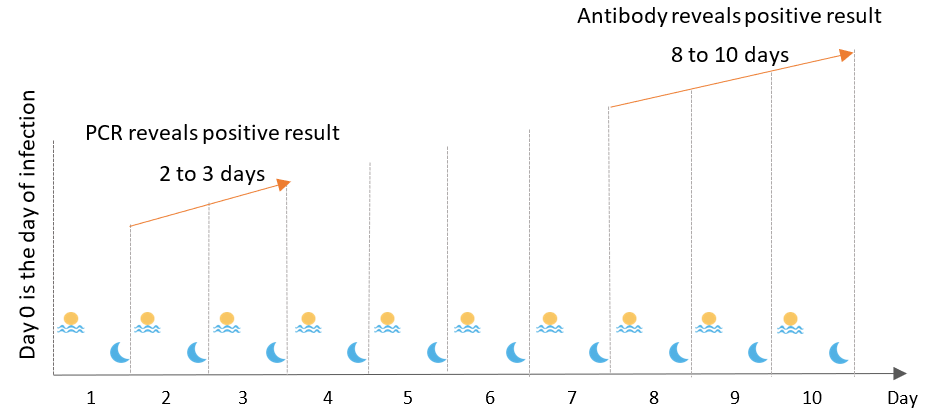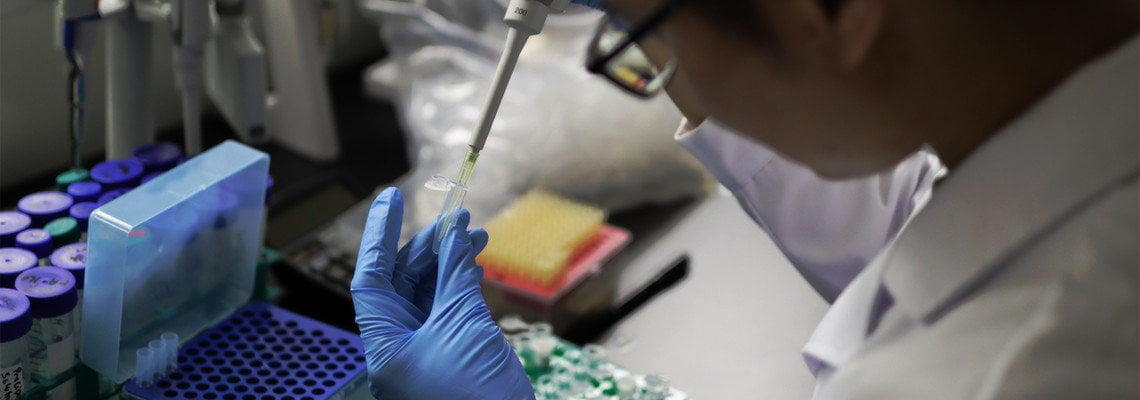COVID-19 Test
There are two available laboratory techniques for detecting COVID-19 pathogens; the first one is antibody blood test (IgG[1] and IgM[2]) and the second is respiratory specimen genetic test (RT-PCR[3]).
1) Antibody Test
Once infected, the body’s immune system will trigger the antibody IgM and IgG production in about 5 to7 days. The principle of this test is to detect the antibodies circulating in the blood to determine whether the tested person has been exposed to the virus.
Advantage: This test is easy and simple to perform. Just a drop blood from a fingertip is applied onto the testing kit and results will be available in 15 minutes. The test could be conducted at home and the price is relatively low (around 1,000HKD).
Shortage: Antibody-based test mostly turns positive in 8~10 days after the disease onset. Viral load is the highest during the first week of disease onset and would decrease later. Therefore, RT-PCR is required for taking early intervention to control the pandemic.
2) RT-PCR Test
RT-PCR detects a unique gene segment of the virus. The detectable level in the body is usually reached 2 to 3 days after infection. Although the turnaround time for RT-PCR is a bit longer (about 6 hours to 2 days), this method directly detects the virus and therefore offers the highest specificity and sensitivity. This means that even if the specimen contains very low amount of the virus RNA, it can be accurately tested. RT-PCR is current golden standard for laboratory diagnosis of COVID-19 in clinical practice. People can only apply for this test through government health department. The price is relatively higher than the antibody test (a few thousand HKD).

Immunity Tests
Telomere length: Telomeres are the primary gatekeepers of genome stability. Their length shortens with each cell division and correlates inversely with age. It can be modified by genetic and epigenetic factors, sex hormones and inflammatory reactions, and it is also sensitive to oxidative stress. A critical minimum telomere length triggers a cell cycle arrest or cell senescence. Therefore, telomere length can serve as a biological indicator and a determining factor of the replicative capacity of immune cells.
Susceptibility of detoxification: Nowadays we are constantly exposed to toxins in the air, food, water, household products and personal care products. Some of the chemicals do not get metabolized or excreted from our body easily, which means the toxins keep accumulating in our body over time. Our body also produces waste such as metabolic products and reactive oxygen species (ROS, especially during the inflammatory response against viral invasion). Our genes determine how sensitive we are to toxins and how effectively our body can excrete them. From better understanding of individual’s detoxification enzyme polymorphisms, we can be better prepared to face this pandemic.
Antioxidants: Inflammation within the body can lead to an increase in ROS. These ROS damage the surrounding tissues. Antioxidants help protect cells and tissues from damage caused by ROS. Vitamin C, vitamin A, vitamin E and master antioxidant glutathione are well-known natural antioxidants which protect our cells against ROS and free radicals.
If you are interested in knowing your telomere length, your detoxification ability, and your current endogenous antioxidants’ levels, or want to learn more about our unique personalized health solutions, please feel free to contact us.
[1] IgM (Immunoglobulin M) is one of the several forms of antibodies that are produced by our body. IgM is the first antibody to appear in the response (primary response) to the initial exposure to the viral antigen, and it generally appears on the 3rd to 5th days after infection and will decline after about 1 to 2 weeks. As the IgM level decreases, the level of IgG antibody increases.
[2] IgG (Immunoglobulin G) is the major type of antibody found in the blood that can enter tissues and fight infection. IgG is the major antibody produced during secondary response.
[3] RT-PCR (Reverse Transcription Polymerase Chain Reaction) measures the amount of a specific RNA from the virus. This is achieved by monitoring the amplification reaction using fluorescence. This technology must be operated by technicians with specific equipment in the laboratory.
Govita fights COVID-19 pandemic together with you!

